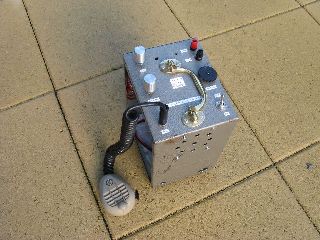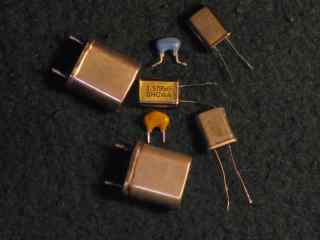QRP centre of activity frequencies
  
CW
QRP clubs around the world list the following frequencies to be centres of CW QRP activity:
10m: 28.060 MHz
12m: 24.906 MHz
15m: 21.060 MHz
17m: 18.086 MHz
20m: 14.060 MHz
30m: 10.116 MHz
QRPers on lower HF bands may also congregate around certain frequencies, with more local variations. For example:
40m: 7.030 MHz (Australia 7.028 MHz)
80m: 3.560 MHz (Australia 3.530 MHz)
160m: 1.810 MHz (Australia 1.815 MHz, UK 1.836 MHz)
Other frequencies are worth checking as well. 7.040 MHz was a popular QRP frequency in the US for homebrew crystal controlled gear. However
it is less useful now for CW as digital modes like WSPR now also operate there. Unless you modify it, the popular Chinese
Pixie transceiver kit comes
with one crystal only. 7.023 MHz is most common but you may also find Pixies on 7.030, 7.040 or 7.050 MHz as well.
Also various CW clubs eg Fists and SKCC have their own 'watering holes', often fairly close to the above QRP frequencies.
SSB/DSB
QRP publications list SSB QRP activity frequencies, but to my knowledge these are less successful than the CW frequencies above. This may be because (a) most serious QRP DXing is done on CW rather than SSB, (b) QRP is more conducive to 'search and pounce' operating where you tune the band looking for other stations calling CQ or finishing a contact, (c) crowded bands (in some countries) makes it difficult to nominate special use frequencies that everyone agrees to (Full power SSTVers have enough problems on 14.230 MHz during a major contest!), and (d) quiet bands (in other countries) mean insufficient numbers to sustain an active QRP frequency.
Ceramic resonators for 3.5 and 7 MHz make frequency agility easy for builders of simple DSB and phasing SSB rigs. So they may heard around the band. You may also hear homebrew SSB/DSB on frequencies for which crystals are cheap and
common, eg 1.843, 3.579, 3.686, 7.159, 7.200 and 14.318 MHz.
AM
AM is a specialist interest on the HF bands. So is QRP. AM QRP is doubly so. AM QRPers are likely to be found on the popular AM frequencies. In the US there is significant AM use just below 3.9 MHz. Here
in Australia AMers often use 7.125 MHz with activity in some areas on 1.825 and 1.843 MHz. 7.159 MHz is another possibility due to the availability of cheap crystals, especially during the day (the frequency
often being busy with SSB DX at night).
Digital modes
Many narrowband digital modes (eg PSK31 and WSPR) work well with QRP and no special frequencies are used or needed. Changes in activity levels have meant that some frequencies which at one time were exclusively used for CW operating are now also used for some digital modes. In some cases this can
create opportunities for cheap hombrew digital modes rigs if you have crystals for frequencies like 3.579, 7.040 or 10.140 MHz.
QRP frequency usage
There are divergent attitudes prevailing towards the so-called QRP frequencies. Sometimes these can cost QRPers successful QRP-QRP contacts.
Some incorrectly regard them as 'calling frequencies' where, once you have established contact, you move. Arranging a QSY can be difficult where signals are weak,
fading and there may be interference. At other times the station contacted may be crystal controlled so they cannot move. Relax! Your licence conditions, your
national society's band plan and even QRP clubs make no
mention of 'calling frequencies'. Regard the frequency like any other and extend normal courtesies to others. But there is no need to move if you aren't interfering with anyone.
Another misconception is that 'QRP frequencies' are for QRPers only. Not so. Amateurs running the legal limit can operate anywhere their regulations permit.
National societies in most countries publish voluntary bandplans that all amateurs should be aware of. In some cases they mention QRP centres of activity. These should be noted but
legally do not have to be avoided.
Some newcomers or returnees to QRP might tune across the QRP centres of activity and hear nothing. They might then put out a couple of calls which may go unanswered. From this they may conclude
there is little QRP activity. This is not necessarily the case. It is very likely there are QRPers but they are on different frequencies working other stations, having practised 'search and pounce'.
While this is a good tactic for the QRP station to get contacts, it makes them harder to work than if they were just calling CQ, because the contact they are making is not on 'their' frequency. So once
it is finished they will likely QSY, with the original station (whose frequency it is) continuing to make contacts. A possible way around this is, in the final transmission you make in a contact,
you nominate a frequency to which you will QSY, listen and call CQ. This allows those who wish to work you the ability to call without disrupting communication on the original frequency.
There are the times that it's good to be slightly away from QRP centre frequencies, especially for long-haul DX on bands where stations can't necessarily hear each other (eg 14 MHz). If you're trying to work
QRP to QRP between Australia and Europe, on 14.060 MHz, for instance, there may be stations unable to hear either you or the station being worked. They might even be calling CQ and inadvertently
interfering. A key operating tactic of QRP includes putting your signal in the clear and that can mean operating a little away from the published centre frequencies.
Key behaviours in QRP include tuning around and listening. Very likely you'll find that only a small proportion of your QRP contacts will take place on the abovementioned centres of activity. But it should
still be possible to have many QRP to QRP contacts if desired.
International beacons
When tuning around the higher HF bands, it
is worthwhile to listen for the International Beacon Project beacons. These
operate on 20, 17, 15, 12 and 10 metres and are located around the world. IBP beacons are particularly useful for
QRPers as their output power is varied over four steps - 100 watts, 10 watts, 1
watt, 0.1 watt. It is often possible to hear the 1 watt transmissions, and sometimes even the 0.1 watt signals. IBP beacons operate on the following
frequencies:
20m: 14.100 MHz
17m: 18.110 MHz
15m: 21.150 MHz
12m: 24.930 MHz
10m: 28.200 MHz
In addition 10 metres has many beacons in the 28.2 - 28.3 MHz segment. A tune across this area can be rewarding when the band is open. These typically run fairly low power so if they can be
heard then there's a fair chance you'll be able to make contacts with QRP.
Generating frequencies
A key point I make in Minimum QRP is that with QRP frequency agility is king. That is because with low power you often have to
meet other stations on their frequency rather than hoping they will find you (ie 'search and pounce'). On the other hand crystal control is tantalisingly simple to build and produces good stable signals
from simple transmitter circuits. A good middle point, for CW equipment, is the variable crystal oscillator which can give a
useful degree of frequency swing while substantially retaining crystal-controlled stability. Another possibility is to use a variable crystal oscillator but with a ceramic resonator substituted. This
gives a much wider frequency swing and is ideal for simple DSB gear such as the Beach 40.
More recently DDS VFOs, either built from scratch or assembled from a kit
have become popular. These are very versatile and make building multiband frequency agile equpiment easier. I'd recommend them as a cheap upgrade for crystal controlled or VXO equipment
but be aware of DDS-generated noise.
Disclosure: I receive a small commission from items purchased through links on this site.
Items were chosen for likely usefulness and a satisfaction rating of 4/5 or better.
|




